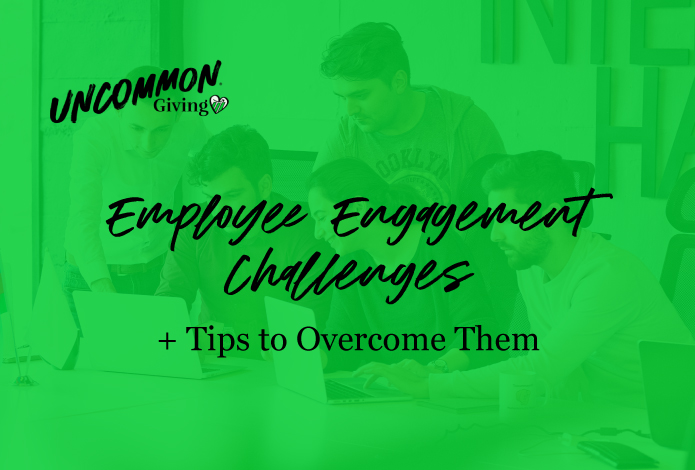
In 2024, employee engagement in the U.S. dropped to 31 percent—a 10-year low. In the face of this decline, it’s more important than ever for companies to take deliberate steps toward improving employee morale and loyalty. Doing so can combat the consequences of low engagement, such as absenteeism, turnover, and productivity losses.
Low employee engagement, however, is a multi-faceted problem that depends on your company’s specific industry, culture, resources, and (of course) employees. Therefore, no two businesses will engage their employees in the exact same way.
That said, learning about common employee engagement strategies and challenges can help your company understand how it’s faring and improve its unique approach going forward. Let’s walk through some basic factors that contribute to a lack of engagement and solutions for overcoming them.
1. Poor Communication and Connection
According to a recent study by USC Annenberg and Staffbase, only 32 percent of employees believe they are receiving enough information at work, and 22 percent rate the quality of news from their employer as “good.” This poor communication can lead to confusion about expectations, conflict between employees, and low morale.
To overcome this challenge, consider:
- Pairing new hires with a mentor to help them feel individually supported.
- Establishing leadership “office hours” to provide a dedicated space for employees to feel heard.
- Scheduling weekly or biweekly one-on-one meetings between managers and direct reports to align on goals and progress.
- Creating and monitoring various communication channels, such as e-mail, instant messaging, or phone calls.
- Send surveys to collect employee input and share updates on implemented feedback.
Remote employees, in particular, are more likely to feel isolated from their company and colleagues. While all companies should host social and teambuilding events, these activities must be a priority if your employees don’t have regular opportunities for face-to-face interaction. Ontra, for example, is a remote-first company that organizes large-scale gatherings twice a year, virtual escape rooms, and networking events to promote connection.
2. Frequent Burnout
A SHRM survey conducted in 2024 found that 44 percent of employees feel burned out at work, and 51 percent feel “used up” at the end of the workday. When employees feel physically, mentally, or emotionally exhausted, it’s much more difficult to feel enthusiastic or committed to their responsibilities. Burnout can even lead to mental and physical illness that further impedes employee positivity and productivity in the workplace.
To overcome this challenge, consider:
- Minimizing “Zoom fatigue” by incorporating breaks between and during long meetings.
- Allowing employees to choose when they start and end their workday.
- Establishing Employee Assistance Programs (EAPs) to provide support services for personal and work-related issues.
- Offering wellness benefits, such as gym reimbursements and free lunches, to help employees care for themselves.
- Encouraging employees to take frequent breaks and use their vacation days.
Additionally, your company can make general office improvements to design a more comfortable and inviting work environment. For example, Trilio is a company that supports remote, hybrid, and in-person work, but offers several office perks for employees who come in. There are dedicated quiet spaces, ergonomic workstations, and a fitness center. Plus, the entire workplace is dog-friendly, so employees can bring their pets to the office.
3. Weak Company Values
It’s no secret that it takes more than a competitive paycheck to motivate, engage, and retain employees in the long term. In fact, Double the Donation notes that 55 percent of employees would accept a lower salary to work for a socially responsible company. If your business doesn’t have a strong set of values to guide its strategic decisions and workplace behavior, your employees might feel directionless and detached from your company’s goals.
To overcome this challenge, consider:
- Incorporating your company’s values into your hiring and onboarding process.
- Testing any new core values with employee focus groups to ensure they resonate.
- Surveying employees regularly about which values they connect with most and which confuse them.
- Using your values to structure performance reviews, such as rating how employees have demonstrated each value over the review period.
- Launching workplace giving opportunities such as matching gifts, payroll deductions, corporate volunteering, and volunteer grants.

According to Uncommon Giving’s Dollars for Doers guide, your company can reinforce its values, help employees give back to their community, and promote workplace unity through team-based volunteer grants. For example, at ConocoPhillips, when teams of four or more employees volunteer at a nonprofit together, they earn a $1,000 donation to the organization for every combined 40 hours they serve.
4. Limited Development Opportunities
When an employee first joins your company, they’re probably looking for opportunities to progress, acquire more skills, and take on new challenges. If employees, especially those who are early in their careers, believe your company isn’t willing to invest in their future, they’re much less likely to invest in yours.
To overcome this challenge, consider:
- Allowing employees to shadow team members in and across departments for a short period of time.
- Enrolling leaders and managers in training programs to prepare them for inspiring teams and delegating responsibilities.
- Offering tuition assistance for employees who want to further their education.
- Encouraging employees to host lunch-and-learns to share their expertise with others.
- Providing access to online courses and Webinars that employees can complete at their own pace.
Try to implement various professional development opportunities to appeal to different learning preferences. For example, HubSpot has a leadership development team that provides training, a tuition reimbursement benefit, a Free Book Program, and other ongoing learning opportunities for employees.
5. Lack of Meaningful Recognition
A recent Workhuman survey found that 46.4 percent of employees only feel somewhat valued by their employer, and 10.7 percent don’t feel valued at all. If your company doesn’t have consistent recognition practices, employees may feel unappreciated for their hard work and become less motivated to put in their best efforts.
To overcome this challenge, consider:
- Spotlighting employees and sharing their accomplishments on social media.
- Sending small gifts, such as a self-care kit, to celebrate employee milestones and work anniversaries.
- Giving out monthly or quarterly awards to the top employees who embody your company values.
- Organizing an annual employee appreciation party to bring your workplace closer together.
- Creating an employee kudos board in the office that makes it easy for peers to show appreciation to one another.
Employee recognition tools can help you create a stronger and more accessible culture of appreciation. From eCards to snack shipments, you’re bound to find an option that resonates with your specific employees. For example, Modivcare is a healthcare services company that designed branded eCards for employees to send for various occasions, from recognizing peers for embodying company values to wishing someone a “happy birthday.”
While overcoming these challenges can significantly boost employee engagement, your company shouldn’t try to tackle them all at once. Start small, focusing on the most apparent areas you can address first, then expand your strategies. Look for tools, such as workplace-giving software, that can streamline and support your efforts so you can focus less on administrative tasks and more on listening to your employees.




